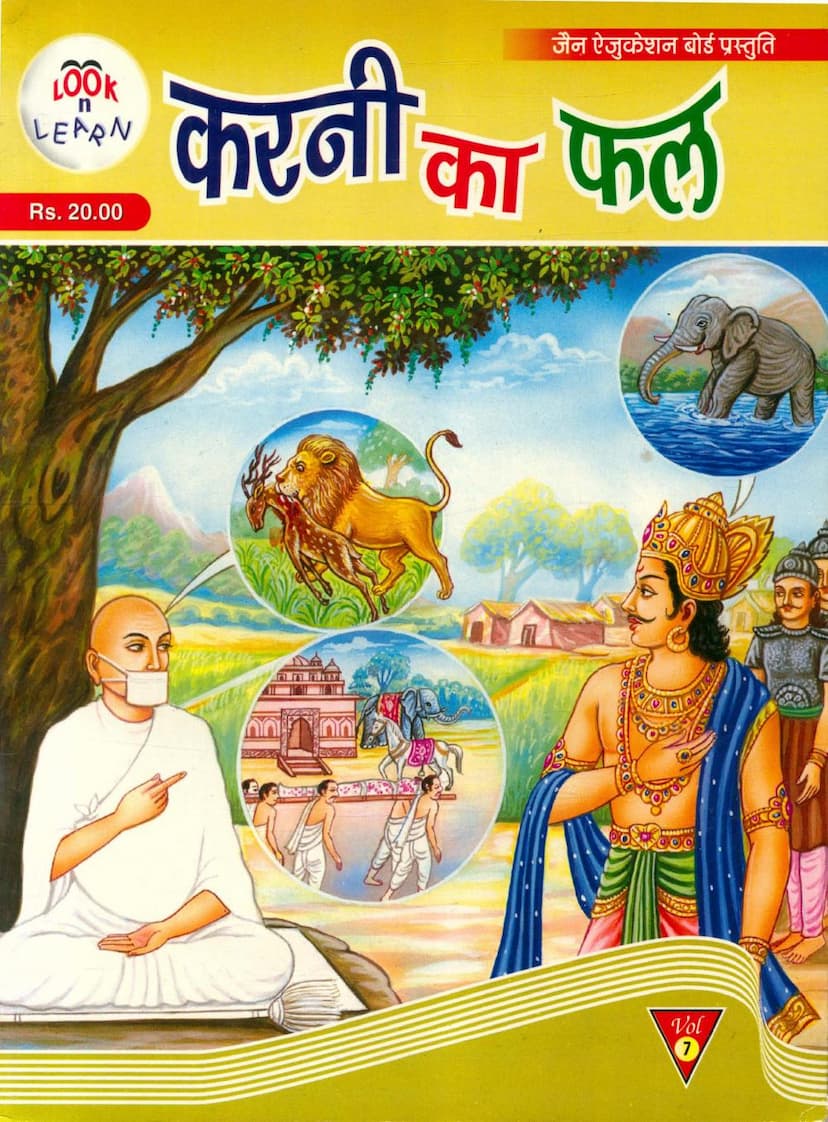Karni Ka Fal
Added to library: September 2, 2025

Summary
Here's a comprehensive summary of the Jain text "Karni Ka Fal" (The Fruit of Actions) by the Jain Education Board, based on the provided pages:
Overall Purpose:
"Karni Ka Fal" is a comic book series published by the Jain Education Board, inspired by the teachings of Gurudev Shri Namramuniji M.S. It aims to impart Jain principles and the philosophy of "Karni Ka Fal" (the consequences of one's actions) to children and adults in an engaging and accessible format. The comic uses the medium of comics and colorful illustrations, recognizing children's preference for this format and their limited time for lengthy texts in today's fast-paced world.
Key Initiatives and Groups:
-
Arham Yuva Group: This group, inspired by Gurudev Shri Namramuniji M.S., is dedicated to service and spiritual practice. Their monthly activities are structured around Sundays:
- First Sunday: Chanting and meditation for peace and solace.
- Second Sunday: Collecting old newspapers (pasti) door-to-door, fostering humility and resilience through experiences.
- Third Sunday: Using the proceeds from selling the collected paper for philanthropic activities – helping the poor, tribal people, the sick, the disabled, the blind, and the elderly. This includes providing material aid, love, comfort, and listening to their stories. They also rescue animals and treat injured ones.
- Fourth Sunday: Visiting Gurudev for spiritual guidance and purification of thoughts and intentions. The Group's activities aim to provide young people with a practical understanding of compassion and service, contrasting the pursuit of worldly happiness with the experience of service.
-
Look n Learn Magazine: This bimonthly magazine is designed for children who are exposed to English-medium education and modern media like cartoons and computers. It presents Jainism's teachings, stories of Lord Mahavir and Tirthankaras, and Jain philosophy in English, Gujarati, and Hindi, using cartoons and engaging formats like coloring contests and quizzes, often with prizes. The magazine aims to make Jain knowledge accessible and enjoyable for young minds.
The Story of King Brahm and Prince Brahm Datta (Chapter 1):
The comic then delves into the story of King Brahm of Kampilpur and his son, Prince Brahm Datta.
- Early Life and Bereavement: King Brahm dies, leaving his 12-year-old son, Brahm Datta, to inherit the throne.
- Guardianship and Betrayal: Four of King Brahm's close royal friends agree to take turns protecting the kingdom until Brahm Datta comes of age. The first guardian, King Dirghraj of Kosal, becomes infatuated with Brahm Datta's mother, Queen Chulni. They begin an illicit affair, disregarding the advice of the loyal Prime Minister.
- Brahm Datta's Awareness and Plan: Prime Minister Dhanu, concerned about the kingdom's welfare and Brahm Datta's safety, instructs his son, Vardhanu, to warn the young prince. Brahm Datta is enraged by his mother's conduct and Dirghraj's betrayal. Vardhanu advises him to use strategy rather than force.
- The Clever Ruse: Brahm Datta, with Vardhanu's help, devises a plan. He ties a cuckoo and a crow together outside Dirghraj's chamber and makes a threatening pronouncement, implying the crow (Dirghraj) is being punished for "playing" with the cuckoo (Queen Chulni).
- Dirghraj's Fear and Conspiracy: Dirghraj, realizing the threat, fears a public uprising. He and Queen Chulni decide to eliminate Brahm Datta. They plot to kill him by building a "Lakshagriha" (a palace made of flammable lac) for his wedding night, similar to the Pandavas' fate in the Mahabharata.
- The Escape: Prime Minister Dhanu, suspicious of the sudden wedding arrangements, sends out spies. Upon discovering the plot to build the Lakshagriha, he secretly facilitates the construction of a tunnel connecting the Lakshagriha to his yajna mandap (ritual site). On the wedding night, as the Lakshagriha burns, Brahm Datta and Vardhanu escape through the tunnel and flee the kingdom.
The Narrative Theme:
The story of Brahm Datta, as presented in the initial pages, highlights the Jain principle of "Karni Ka Fal" – the concept that one's actions have consequences. The betrayal of Dirghraj and Queen Chulni, and Brahm Datta's subsequent hardships and eventual triumph, illustrate this karmic law. The text emphasizes that even in the face of adversity, strategic thinking and reliance on righteous principles can lead to overcoming challenges. The overall message promotes ethical conduct, loyalty, and the importance of acting with wisdom and foresight.
Further Developments (from subsequent pages):
The subsequent pages detail Brahm Datta's journey after his escape, his training in warfare and politics, his eventual return to reclaim his kingdom, and his rise to become a Chakravarti (Emperor). The narrative also explores themes of past lives, the transmigration of souls, and the impact of karma across lifetimes, as illustrated by Brahm Datta's recurring experiences and his encounter with a sage who reveals his past lives. The story ultimately culminates in the realization that while worldly power and pleasure are temporary, adherence to Dharma (righteousness) and the destruction of negative karma are crucial for true and lasting happiness. The text concludes with Brahm Datta's realization of the cyclical nature of karma and the importance of good deeds.